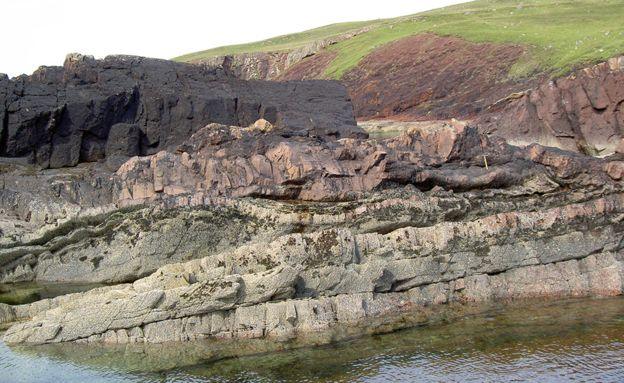Scotland may have its very own meteorite crater!
- Published
- comments

A team of scientists believe that an ancient meteorite crater may be hidden deep in the sea near Scotland.
The structure is thought to be in The Minch, a body of water which separates the north-west Highlands from the Outer Hebrides.
Signs that an asteroid may have created an impact crater near the Scottish town of Ullapool were first identified back in 2008 by geologists at the universities of Oxford and Aberdeen.
The collision is thought to have been caused by an object travelling at a whopping 38,000 mph and is believed to have created an impact crater 12 miles wide.
The main evidence for the crater's existence are reddish-coloured rocks on the eastern side of The Minch which are collectively known as the Stac Fada deposit.
It was originally linked to volcanic activity, but the team later realised that the material had been thrown out from a layer of rock following a huge collision that took place over a billion years ago.
Geologists now believe they can pinpoint exactly where the asteroid hit Earth, although the specific location is said to exist deep below the seafloor.
If it is confirmed that the collision happened, it will be the biggest to have ever taken place in the British Isles.
What is an impact crater?
An impact crater is a deep circular hole created by a object, such as a meteor, colliding with a surface. Impact craters can be found on the Moon, as well as on other planets within our solar system.
Impact craters are created when objects collide with the Moon's surface
Impact craters from around the world
The Karakul is a mountain lake located in eastern Tajikistan. Karakul was formed by a meteorite impact which took place approximately 25 million years ago and left a crater which was roughly 45 kilometres wide.
Vredefort crater in South Africa is the largest and second oldest impact crater on Earth. It was formed about two billion years ago and is believed to have had an original diameter of 300 kilometres.
Acraman crater, which is found in the Australian outback, was created by an asteroid which hit Earth almost 600 million years ago. The crater is largely eroded and is marked by Lake Acraman, which is a dry lake.
Roter Kamm, which is located in the Namib desert, is an impact crater which geologists believe was caused by a a meteorite about five million years ago. It is about 2.5 kilometres wide and its floor is covered by sand deposits.
Lonar Crater Lake is located in India. The lake was formed over 50,000 years ago and is said to have been created by a meteorite which hit the area at a speed of 90,000 kilometres per hour.
- Published8 March 2018
- Published22 March 2019
- Published1 March 2016
- Published3 June 2019
